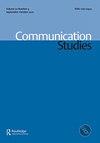Bridging the Gaps: Advancing the Communication Theory of Identity
IF 1.4
Q2 COMMUNICATION
引用次数: 0
Abstract
ABSTRACT Extending the focus and scope of the communication theory of identity (CTI), this paper introduces a new theoretical construct within CTI’s interpenetration of frames – identity bridging. Theoretical extensions of CTI have established identity gaps, which are inconsistencies between individuals’ personal, enacted, relational, communal, and material identities. Identity bridges represent individuals’ responses to identity gaps. Identity bridging consists of psychological, behavioral, and communicative responses to identity gaps. This paper aims to define identity bridging, outline how past literature advocates the validity of the new construct, examine how identity bridging can be integrated into CTI, explore the relationship between identity gaps and identity bridging, propose extensions to CTI’s current assumptions, and discuss implications and future research directions.弥合差距:推进身份传播理论
本文扩展了身份通信理论(CTI)的研究重点和范围,介绍了CTI框架互穿中的一个新的理论结构——身份桥接。CTI的理论延伸已经建立了身份差距,这是个人的个人身份、制定身份、关系身份、社区身份和物质身份之间的不一致。身份桥梁代表个人对身份差距的反应。身份桥接包括对身份差距的心理、行为和沟通反应。本文旨在定义身份桥接,概述过去文献如何倡导新结构的有效性,研究身份桥接如何融入CTI,探索身份差距与身份桥接之间的关系,提出对CTI当前假设的扩展,并讨论其影响和未来的研究方向。
本文章由计算机程序翻译,如有差异,请以英文原文为准。
求助全文
约1分钟内获得全文
求助全文

 求助内容:
求助内容: 应助结果提醒方式:
应助结果提醒方式:


